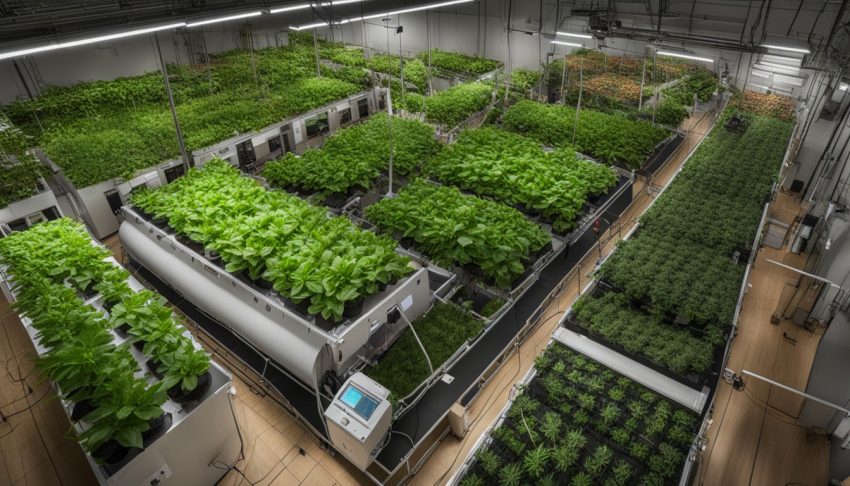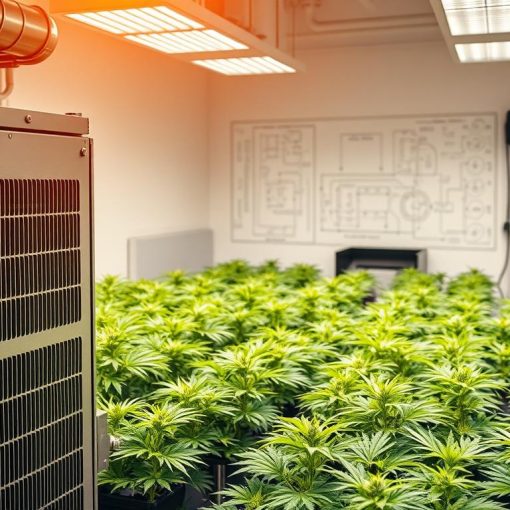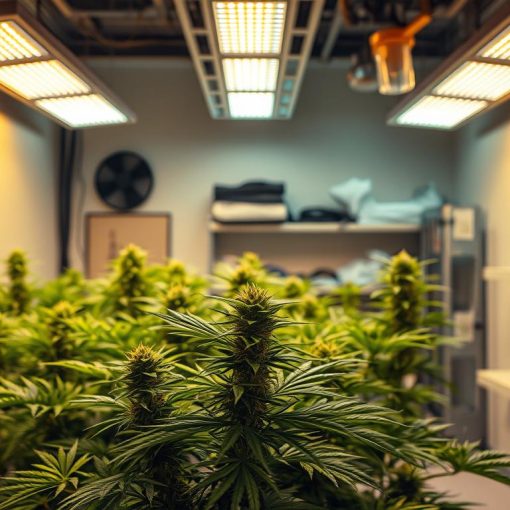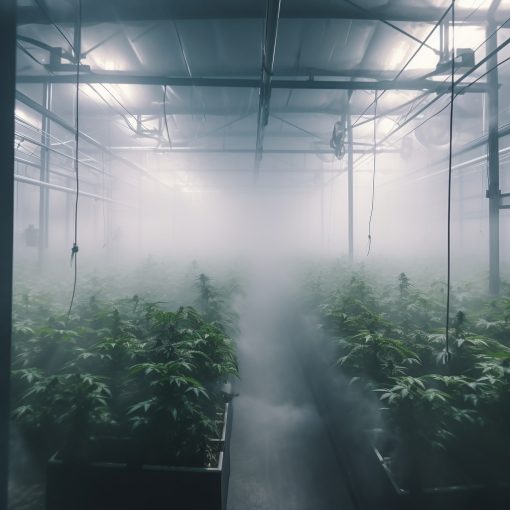For optimal cannabis cultivation in an indoor setting, precise control over temperature, humidity, air circulation, and CO2 levels is vital. Mastering the environmental control in a grow room is crucial for enhancing plant health, potency, and yields. By fine-tuning these factors, cultivators can craft the perfect conditions for their cannabis plants to flourish.
Effective climate control in a grow room setup fosters robust plant growth and wards off common issues like mold, pests, and nutrient deficiencies. TriCleanAir offers custom cannabis climate control systems that aim to cut energy consumption while elevating plant production and quality. With the right equipment and strategies, growers can tailor the environment to their crops, resulting in consistently outstanding harvests.
Key Takeaways
- Proper environmental control is crucial for optimizing cannabis cultivation in indoor grow rooms
- Key factors to regulate include temperature, humidity, air circulation, and CO2 levels
- Maintaining ideal conditions prevents issues like mold, pests, and nutrient deficiencies
- Custom climate control systems from TriCleanAir reduce energy use and increase plant production
- Mastering grow room environment leads to healthier plants and consistently impressive yields
Understanding the Importance of Grow Room Environmental Control
Mastering the art of grow room environmental control is crucial for optimal plant health and yield. It also helps in preventing pests and diseases in indoor cannabis cultivation. By setting up ideal conditions, growers can foster vigorous growth and abundant flower production. This approach minimizes the risk of crop loss due to environmental stressors.
Proper environmental control lets cultivators adjust temperature, humidity, air circulation, and CO2 levels for each plant stage. This precision optimizes photosynthesis, nutrient uptake, and overall development. As a result, plants become healthier, leading to higher yields.
“TriCleanAir manufactures custom cannabis climate control systems for your facility. Our systems reduce energy use and increase plant production and health.”
Effective environmental control is key to preventing pests and diseases. Stable temperatures, humidity levels, and air circulation make the environment less hospitable to pests and pathogens.
- Proper temperature control prevents mold, mildew, and other fungi that can destroy crops.
- Optimal humidity levels reduce fungal infections and deter pests like spider mites and thrips.
- Good air circulation ensures even temperature distribution, strengthens stems, and prevents air pockets.
A well-designed environmental control system leads to consistent and predictable results over multiple grow cycles. It eliminates the uncertainty of manual control, making operations more efficient. This approach reduces labor costs and ensures high-quality, uniform cannabis harvests.
Key Factors in Grow Room Environmental Control
Creating the perfect environment for cannabis plants involves a fine balance of several key factors. By managing temperature, humidity, air circulation, and CO2 levels, growers can enhance their grow room conditions. This approach supports healthy plant growth and boosts yields.
Temperature
For cannabis plants, the right temperature is crucial for development. Most strains thrive between 70°F and 85°F (21°C to 29°C) during the light cycle. In the dark cycle, the ideal range is 58°F to 70°F (14°C to 21°C). Consistency is vital, as temperature swings can stress plants and slow growth.
Humidity
Humidity is essential for plant transpiration and nutrient absorption. The ideal humidity levels change with the growth stage. During the vegetative phase, it should be 60-70%. In the flowering phase, aim for 40-50%. Proper humidity levels prevent mold and mildew.
Air Circulation
Good air exchange is crucial for a healthy grow room. It helps regulate temperature and humidity, prevents stagnant air, and strengthens stems. Using oscillating fans and exhaust systems ensures a consistent airflow. This distribution of temperature, humidity, and CO2 is vital for plant health.
CO2 Levels
CO2 enrichment boosts plant growth and yields when paired with suitable light and temperature. The ideal CO2 concentration for cannabis is 1200 to 1500 ppm. Yet, it’s crucial to ventilate properly and monitor levels to avoid harming the plants.
By monitoring and adjusting these environmental factors, growers can optimize their cannabis plants’ conditions. TriCleanAir offers custom climate control systems. These systems maintain the ideal temperature, humidity, air exchange, and CO2 levels. They also reduce energy use and improve plant health and production.
Optimizing Temperature for Plant Growth
Temperature control is crucial in grow rooms, affecting plant growth, development, and health. It’s vital to maintain the ideal temperature for each growth stage to enhance yield and quality. Growers must balance heat for photosynthesis and respiration, avoiding excessive temperatures that stress plants.
Advanced HVAC systems, like those from TriCleanAir, are essential for precise temperature control in cannabis cultivation. These systems are tailored to each facility’s needs, ensuring efficient heating, cooling, and ventilation. Investing in a quality HVAC system helps maintain consistent temperatures, crucial for plant health.
Insulation is key to maintaining stable temperatures in grow rooms. Insulating walls, ceilings, and floors reduces heat loss in cold months and heat gain in warm ones. Popular insulation materials include closed-cell spray foam, rigid foam boards, and reflective bubble insulation.
Canopy temperature is also vital, differing from ambient air temperature and affecting plant health. To optimize it, growers can:
- Adjust light intensity and distance
- Use air circulation fans
- Implement a vapor pressure deficit (VPD) monitoring system
- Apply foliar sprays to cool the canopy
“By carefully monitoring and adjusting canopy temperature, growers can create an ideal microclimate that promotes healthy plant growth and maximizes yield potential.” – Dr. Amber Johnson, Plant Physiologist
Optimizing temperature for plant growth requires a holistic approach. This includes investing in quality HVAC systems, ensuring proper insulation, and actively managing canopy temperature. Prioritizing temperature control supports vigorous plant development and exceptional results.
Maintaining Ideal Humidity Levels
Humidity is vital for cannabis plant growth and development. It’s crucial to keep humidity levels optimal for healthy growth, mold prevention, and high yields. Understanding relative humidity and dehumidification techniques helps growers create the best environment for their plants.
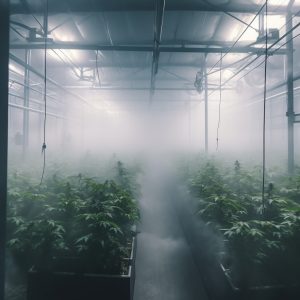
Relative Humidity and Plant Health
Relative humidity (RH) measures water vapor in the air compared to its maximum capacity at a temperature. Cannabis plants need specific humidity levels at different growth stages. In the vegetative stage, they thrive in 60-70% RH. As they move to flowering, humidity should drop to 40-50% to avoid mold on buds.
Humidity affects plant transpiration, the process of water release through leaves. High humidity slows down transpiration, reducing nutrient uptake and growth. Low humidity causes excessive transpiration, stressing plants and stunting growth. The right humidity balance is key for healthy plants.
Dehumidification Techniques
Growers use dehumidification techniques to keep humidity in check. Dehumidifiers are a top choice, removing moisture from the air. They vary in size and capacity, fitting different grow rooms and humidity needs.
Good ventilation is also crucial for humidity control. Exhaust and intake fans create balanced airflow, removing excess moisture. Air conditioning systems cool and dehumidify the space, vital in humid areas.
Managing humidity through vapor pressure deficit (VPD) is another method. VPD measures moisture difference between air and its moisture capacity at a temperature. Adjusting temperature and humidity to an optimal VPD range supports healthy transpiration and growth.
| Growth Stage | Ideal Relative Humidity Range |
|---|---|
| Seedling | 65-70% |
| Vegetative | 60-70% |
| Flowering | 40-50% |
| Late Flowering | 30-40% |
Effective dehumidification and regular humidity checks ensure an optimal environment for cannabis plants. This approach supports healthy growth, prevents mold and mildew, and leads to better yields.
Ensuring Proper Air Circulation
Proper air circulation is vital for a thriving grow room environment. It ensures a healthy and productive space for plants by distributing CO2 evenly. This gas is crucial for photosynthesis and growth. Moreover, it helps regulate temperature and humidity, preventing hot spots that can lead to mold and other health issues.
Benefits of Air Movement
Effective air circulation boosts plant health in a grow room. It strengthens stems and encourages robust growth, mimicking outdoor conditions. The gentle sway from air movement helps plants develop sturdy stems, ready to support heavy yields. Additionally, it ensures plants get fresh, oxygenated air while removing stale air, crucial for a healthy ecosystem.
Choosing the Right Fans
When selecting fans for your grow room, consider oscillating and inline fans. Oscillating fans create a gentle breeze that mimics natural wind, ensuring air reaches all plants evenly. Inline fans, on the other hand, are for powerful ventilation, pulling in fresh air and expelling stale air through ductwork.
Choosing the right fan size and quantity depends on your grow room’s size, plant density, and the needs of your plants. Aim for a full air exchange every 1-3 minutes for optimal conditions. High-quality oscillating and inline fans can create a well-circulated environment, promoting healthy growth and high yields.
TriCleanAir manufactures custom cannabis climate control systems for your facility. Our systems reduce energy use and increase plant production and health.
Implementing CO2 Enrichment Strategies
CO2 enrichment is a crucial technique for boosting plant growth and increasing yields in grow rooms. By upping the CO2 levels, growers enhance photosynthesis, leading to quicker growth and healthier plants. For cannabis, the ideal CO2 ppm range sits between 1000 and 1500 ppm, significantly above natural levels.
Growers can use several strategies for CO2 enrichment. CO2 generators, which produce CO2 from propane or natural gas, are a favored choice. These can be automated to keep CO2 levels steady in the grow room. Alternatively, CO2 burners convert CO2 into a plant-friendly form through a catalytic reaction.
Bottled CO2 is another viable method for enriching the air in grow rooms. It involves releasing CO2 from pressurized tanks directly into the space. Though pricier than other methods, it provides precise control over CO2 levels, making it suitable for smaller setups.
Regardless of the method, it’s vital to monitor and maintain optimal CO2 levels. CO2 sensors and controllers allow growers to track CO2 ppm levels in real-time. This ensures plants get the right amount of CO2 for peak growth and yield.
TriCleanAir manufactures custom cannabis climate control systems for your facility. Our systems reduce energy use and increase plant production and health.
By employing CO2 enrichment strategies and closely monitoring CO2 levels, growers can craft an ideal environment for their cannabis plants. This leads to vigorous growth and bountiful harvests. Achieving the right balance and tailoring to your plants’ specific needs is essential for success in grow room environmental control.
Lighting and Its Impact on Grow Room Environment
Lighting is a pivotal element in managing a grow room’s environment, directly affecting temperature and plant growth. Selecting the right grow lights and controlling their intensity is vital for creating ideal conditions for your plants. This section delves into the relationship between light intensity and temperature, along with strategies for balancing lighting and cooling in your grow room.
Light Intensity and Temperature
The intensity of grow lights significantly impacts the temperature in a grow room. High-intensity discharge (HID) lights, like metal halide (MH) and high-pressure sodium (HPS) lamps, produce a lot of heat. This heat can stress plants, causing nutrient deficiencies, stunted growth, and reduced yields.
Many growers are switching to LED lighting to reduce heat. LED grow lights are energy-efficient and generate much less heat than HID lights. This makes it simpler to maintain optimal temperatures in your grow room, even with high-intensity lighting.
Balancing Lighting and Cooling
Striking a balance between lighting and cooling is crucial for creating the ideal environment for plants. When using high-intensity grow lights, effective heat management is necessary to keep temperatures stable. Strategies include:
- Installing high-quality ventilation systems to remove hot air and bring in cooler air
- Using air-cooled reflectors or cool tubes to dissipate heat from HID lights
- Incorporating air conditioning units or water-cooled systems to regulate temperature
- Adjusting the height of your grow lights to maintain the appropriate distance from your plants
Managing temperature is essential, but so is providing the right amount of light intensity for each growth stage. Concepts like photosynthetic photon flux density (PPFD) and daily light integral (DLI) are crucial here.
PPFD measures the amount of photosynthetically active radiation (PAR) that reaches your plants at a specific point, while DLI represents the total amount of PAR your plants receive over the course of a day.
By monitoring and adjusting PPFD and DLI levels, you can ensure your plants get the right amount of light for optimal growth and development. Combining this with effective temperature management will help you create a thriving grow room environment. This maximizes plant health and yields.
Monitoring and Controlling Grow Room Environmental Parameters
To ensure optimal plant growth and health, accurately monitoring and controlling the grow room’s environment is crucial. Advanced climate control systems, sensors, and automation technologies have transformed how cultivators manage their indoor spaces. These tools allow growers to maintain ideal conditions for their plants with minimal manual effort and lower energy use.
Environmental Control Systems
Systems like those from TriCleanAir offer a comprehensive solution for managing grow room conditions. They regulate temperature, humidity, CO2 levels, and air circulation for optimal plant growth. By controlling these parameters precisely, cultivators can enhance yields and produce high-quality crops consistently.
TriCleanAir’s systems are designed to cut energy use while boosting plant production and health. They use advanced sensors and automation to monitor and adjust conditions in real-time. This ensures your plants always get the best environment for growth.
Sensors and Automation
Using sensors and automation are key for logging and monitoring grow room conditions effectively. Sensors throughout the room collect data on temperature, humidity, CO2 levels, and more. This data is sent to a central system for real-time monitoring and analysis.
Automation technologies, like programmable controllers and smart devices, let growers adjust settings remotely based on the data. This control and flexibility help cultivators respond quickly to environmental changes. It ensures plants get the best conditions for growth and development.
By using sensors and automation, cultivators can:
- Maintain precise control over environmental parameters
- Receive real-time alerts and notifications of any deviations from optimal conditions
- Remotely monitor and adjust settings from anywhere using mobile devices or web-based platforms
- Analyze historical data to identify trends and optimize growing strategies
Investing in advanced systems like those from TriCleanAir empowers cultivators to create the ideal environment for their plants. By harnessing climate control, sensors, and automation, growers can achieve consistent, high-quality yields. This approach also reduces labor and energy costs.
Conclusion
Mastering the control of your grow room’s environment is crucial for successful cannabis cultivation. It ensures optimal plant health, yield, and quality. Understanding the importance of temperature, humidity, air circulation, and CO2 levels is key. This knowledge allows cultivators to create the perfect conditions for their plants.
By implementing best practices for grow room optimization, such as maintaining optimal temperature ranges and managing humidity levels, you can boost your cannabis plants’ performance. Proper air movement and CO2 enrichment strategies are also vital. Investing in advanced systems, sensors, and automation can help you monitor and regulate these parameters effectively.
For the best results, consider partnering with TriCleanAir for their custom cannabis climate control solutions. Their systems are designed to reduce energy consumption while maximizing plant production and health. With their expertise and technology, you can elevate your cannabis cultivation to new heights. Achieving the highest quality harvest becomes attainable.

